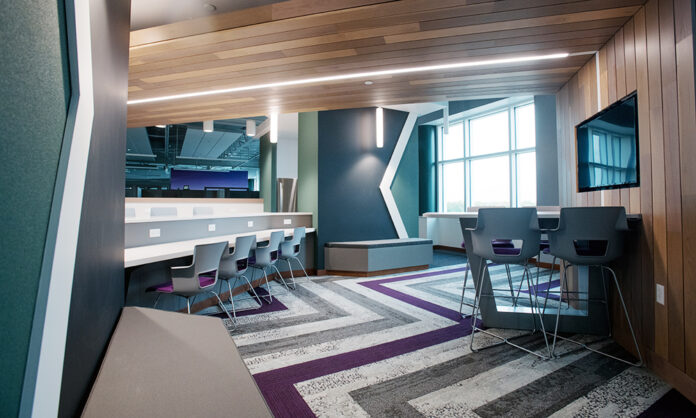There are many variables to consider when making decisions about managing your templates. One of the main ones is the physical capacity of the workspaces, which will determine how many people will be able to be in the office at the same time, complying with the rules of physical distance.
In the midst of this uncertainty, a good leader must know how to address the new challenges that arise in real-time and design a plan so that their staff is flexible and strong in the face of challenges.
To do this, you will have to consider whether it is necessary for some of the employees to work remotely and the other in person or even take turns between them to sometimes carry out the work from the office, and others from home with the help of Klaxoon.
1. Focus On Your Team

In a situation like the current one, communication with workers is essential for everything to work properly. In addition to dealing with work issues, it is important to know what they think, how they feel, or what their concerns are. Being aware of everything that happens in relation to the staff can give you the keys for the business to work at 100%.
It is time to be open to new ways of working, and the opinion of employees is essential to know if the proposed measures work and if they can be improved or not.
On the other hand, for some people, going back to the office can cause an anxiety situation for fear of contagion or crowds. Your role in these cases will be to reassure them and do everything possible to make them feel comfortable at all times.
You must equally support the part of your team that is present in the workplace and the part that is telecommuting.
2. Clearly Define Roles

There are functions that can only be carried out in the workplace, while others can be carried out remotely without difficulty.
To achieve the balance between the people who will telecommute and those who will not, several factors must be taken into account that will allow the proper distribution of teams, such as security, physical distancing, productivity, or necessity. To do this, you can ask yourself the following questions:
- How many employees can be in the office at the same time, complying with safety and distancing regulations?
- Are there some workers who would be more productive in the office than outside of it?
- Are there people who prefer to stay home for a special reason? Are there others who prefer to be in the workplace?
- How many employees are strictly necessary within the office?
- What functions cannot be performed by telecommuting?
Once the distribution and rotation possibilities are clear, define precisely the role that each person will assume at each moment. New needs may have arisen in this time and, with them, new tasks. Inform and train your teams to achieve exemplary performance.
3. Redesign Workspaces

Reorganizing the work area to properly comply with government regulations and social distancing rules is a must. But it also represents a new opportunity to modernize the environment and redefine the work style, with more open, diaphanous, and collaborative spaces. To carry out this redesign you must think about what is best for your company and your employees.
Start with the areas that will undergo the most changes; these are the ones with the highest concentration of workers: their jobs. It is committed to a slightly more ecological and easy to disinfect remodeling, in which the furniture will play an important role, also to favor the implementation of the necessary means to accommodate the digital transformation, more necessary than ever. Computers, projectors, large screens for massive videoconferences.
On the other hand, make sure that people who work remotely have the right tools and resources to ensure correct and efficient teleworking.
4. Make Gradual Changes

In the same way that the economy was reactivated in phases during the de-escalation, following a similar approach with your company will be of great help. It is important to have a solid strategy with which you make sure that your business is not going to weaken and production is going to remain unchanged.
You can start incorporating part of the template and observe how it adapts to design in the following stages.
5. Be Nimble

The first stages of returning to the office can be taken as a test. It is the best time to observe what works well and what does not and, in this way, assume the changes that are pertinent.
Flexibility is essential in this situation; you have to be willing to modify what is necessary to achieve optimal functioning and environment. Also, with so many people working in different places and times, you must open your mind to different ways of doing things, to try new protocols and tools. In this way, both you and your team will have room to innovate and you will be able to discover new ways of operating.
6. State Goals And Expectations

Even in a changing environment, in which new ways of working are being tested and it is not certain what will happen in the medium and long term, you must establish goals and expectations, both for people who work from the office permanently and for those who do not work. They do it from home, without forgetting those that do it in a hybrid way.
Express clearly what you expect from your workers and where the company is headed. Communicating with them in a transparent and constant way is key to ensuring that they have a good understanding of what their functions are and checking if they agree with the changes that are being made.
7. Build Bridges Between Remote And Face-To-Face Professionals

Another of the challenges that you will have to take on will be to create a united work environment, even if part of the staff works remotely. Making frequent calls or video conferences will make your employees not feel alone in certain situations, and will help them quickly resolve any questions that may arise during their working day.
Chain emails, instant messaging, or video conferencing applications are also useful to generate conversation and, in this way, forge a feeling of union between colleagues.
Look for what tools can be most useful for your type of business. Test them with your employees and ask them for feedback to see if they are effective or not. Working together efficiently in a delocalized way is possible.









